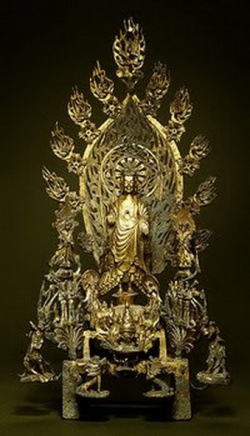Small and Great Vehicle
The early history of Buddhism is less then clear. There have been a handfull of conciles to fix the teachings of the Buddha, the concile of Pataliputra in 245 BC tried to fix the teachings in book form, the so called "Three Baskets Canon" Tripitaka. It is fully preserved in Pali language and consists of the writings about discipline (vinaya, chin.: lü 律), teachings (sutras), and comments (abidharma 論). When Buddhist parishes divided into different sects, is not known. The more conservative form of Buddhism is the confession Theravada ("Way of the Elders"; also called "Small Vehicle", Hinayana, chin.: Xiaosheng 小乘 [not cheng!]), basing on the Pali canon. It is a discipline for personal salvation by the individual, possible only for those who join the monasteric order as monk or nun, at least for a short time, to accumulate enough meritorious karma for one's own salvation. In this way, Buddhism is only a caste-less Hinduism that makes it possible to escape rebirth. Theravada Buddhism spread over Ceylon, Burma and the Indochina Peninsula. The confession of the Great Vehicle, Mahayana (chin.: Dasheng 大乘), instead spread from Kashmir, Gandharaa and Inner Asia into China, and further to Korea and Japan. It teaches that salvation is possible to all sentient beings because they posses the Buddha nature in them and hence all have the potentiality of being enlightened. Enlightenment is simply achieved by faith and devotion to Buddha and the religious ideal, the Bodhisattva (chin.: Pusa 菩薩), Pratyekabuddha (chin.: Pizhifo 辟支佛) or Arhat (chin.: Aluohan 阿羅漢, short: Luohan). These beings, though qualified to enter nirvana, delay their final entry in order to bring every sentient being across the sea of misery to the calm shores of enlightenment. The most important Bodhisattvas are Manjushri (chin.: Wenshushili 文殊師利), the Bodhisattva of Wisdom, Avalokiteshvara ("Observing the Sounds of the World", chin.: Guanshiyin 觀世音, short: Guanyin, or Guanzizai 觀自在), the Bodhisattva of Compassion, and Samantabhadra ("Universal Goodness", chin.: Puxian 普賢), the Meditation Teacher. Buddha appears in different shapes, according to the belief that Buddha appears in every age in a special appearance, like Amitabha (Amitayus, "Buddha of Endless Light", chin.: Namo Amituofo 南無阿彌陀佛, jap.: Amida Butsu) or Vairocana "Universal Illuminator" or Lokeshvaraja (chin.: Pilushena 毘盧舍那, short: Lushena), the Buddha of the Past; Maitreya (chin.: Milefo 彌勒佛), the Buddha of Future. The Light Buddhas are clearly an influence of Iranian religion with the god of light, Ahuramazda. Compare a text from the Large Amitabha Sutra. Popular Great Vehicle Buddhism is very fond of describing and depicting hells and heavens and the many Arhats, best seen in the wall paintings of Dunhuang.
